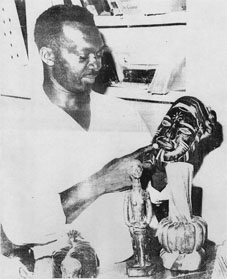Another very brief sermon today. I suspect that I might have even used the caption years ago and that I would have discussed, in layman’s terms, issues related to publishers’ priorities or prerogatives, editorial policy and the fact that, in the print media, bad news attract interest, attention – and money
Just a little more of the same today. But related to a vicarious, very indirect, connection to a murder on Monday. This past Tuesday’s Guyana newspapers all screamed of death, murder on their front pages. Even the good-news Chronicle joined the fray and featured news of four tragic deaths which occurred on Monday and over the week-end.
Naturally, various responses from right-minded citizens who still care flowed. And the implications of the deaths, especially the murders, are so many and so equally negative. From personal, community and national perspectives.

First of all, should the sordid details of crime and murders and fatal accidents be accommodated on the front pages? Why not? Many publishers and editors would argue. They are accurate news – reporting on any page.
I suppose so, but, believe it or not, some ‘papers – as in a few little tourist- islands – tend to spare readers the front page splurge.
That policy is informed by the thinking that front-page reported crime is bad for national image, attractiveness and investment. However, in today’s open-information, instant technology – societies, it’s difficult to hide crime or any negative. Our Chronicle newspapers try their best to be positive on their front-pages. But guess how their circulation is faring.
******
Reflecting reality?
Frankly Speaking, to me our private sector newspaper editors have long decided to adopt a policy of telling-it-all when savage crimes occur. To me, they have decided that these behaviours reflect the reality of Guyanese society these days . The reporters, editors and their publishers are probably saying that, like corruption, race-based politics and cheap fashion, murders and recklessness on the road indicate our loose morality, national indiscipline and disrespect for laws and authority. Are they not right?
No matter how we place in the Region or how many scholarship winners are announced, our education system is not producing enough young citizens who can now reason things out, who can tolerate opposing views and positions or who truly see religion as instilling wholesome appropriate values which speak to a higher cultured, morality. Crassness and ignorance rule – in the school, the mini-bus, the hinterland.
Inside the pages of the newspapers, we read of the failures of prosecution when suspected murderers and really big drug-traffickers do get to Court. The ignorant aggressive youngsters and bandits know that even if the prosecution is “reasonable” the murder charge is reduced to manslaughter. “Good” behaviour and he/she is soon out of prison. Some life is gone for good, however.
No doubt about it, crime will continue to attract today’s front pages. Discuss…
Oh, I mentioned an “indirect connection” to one of Monday’s murders. That has to do with the fact that Mr. Bert Whyte greeted me warmly, as he usually would do, probably less than two hours before he was killed. He was sitting a few yards from me then, on Monday afternoon. (This fragile life, in this cruel society)
Mr. Moore and me
This is my manner of tribute to the fallen Phillip Alfonso Moore.
As was expected and as is justifiable, numerous are the tributes celebrating the life of Guyana’s most natural but philosophical sculptor and artist. There was bound to be repitition in those messages of admiration and praise.
My claim to “knowing” Mr. Moore makes me state that, for me, it is difficult to keep the name of Vic Insanally, out of the Arts in this country. Most times, he prefers the background. I believe he was on some Castellani National Gallery Committee when both Moore and Janet Jagan would joust about art at many a meeting. And it was Vic who arranged for me to sit with Moore on the occasion of his 80th birth anniversary and to spend three days using video tape to hear Phillip explain the pieces now kept by Castellani. That was an experience. I lost him on many a piece.
In fact, at Waterchris, I would sometimes dodge Phillip as he sought to send certain messages to “the authorities” through me. You really had to have time to sit with Moore over the past five years. He could be really absolute and extreme at times. Let Tom Dalgetty tell you which “symbols of mental oppression” Phillip would have removed from Georgetown. For starters.
This is what Wordsworth McAndrew wrote about the emergent Phillip Moore fifty years ago:
“In an untrained sculptor who can no doubt trace his descent to one of the many sculpturally-gifted tribes of West Africa, this should not be surprising, but when one considers that sculpture as a folk-art is singularly absent from the ancestral panache of the African-descended Guyanese and that this is also true of the East Indians who comprise nearly half of the Colony’s population (roughly 46.4%, in fact), then the full magnitude of Philip Moore’s contribution to Guyanese art is easily apparent.
Nor does Philip allow the fact that he is the country’s only known folk sculptor to go to his head. He is continually producing, continually working out new ideas and techniques and unceasingly striving to improve his art, through he has so far rejected the idea of trying to get into an art school, on the ground that such esoteric training would denude his work of its “folkness”.”
Ponder …
*1) I do feel a bit “put off” seeing the name of the American University where Critchlow Labour College should be dominant. Re-think Ivor?
*2) Does a picture of a horrible, wrecked vehicle in which persons died deter wild young drivers? Think so?
*3) Poor West Indies now in England – such harsh descriptions Waifs? Strays?
Beat them, fellas!
‘Til next week
(Comments? allanafenty@yahoo.com)





